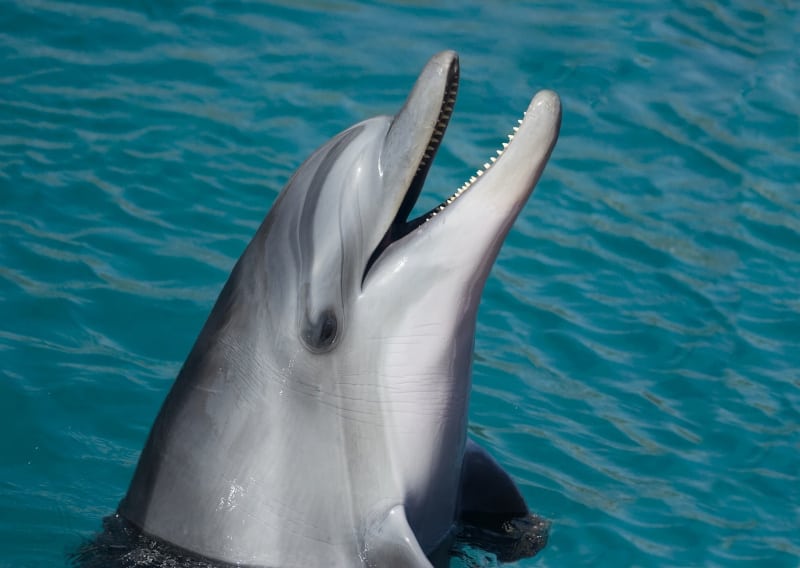
Common Bottlenose Dolphin Facts
- This magnificent ocean-dwelling creation of evolution generally goes by the intriguing name of the Common Bottlenose Dolphin. It does have a very similar alternate general name, though. That’s the informative moniker of Atlantic bottlenose dolphin.
- Within scientific circles, however, it’s better known by its technical name. Fortunately for the layperson, that’s the relatively easy to pronounce term of Tursiops truncatus. No matter which term one chooses, it remains a beautiful and impressive creature.
- It received that official name due to the efforts of the English naturalist, George Mantagu. He accomplished the first recorded acknowledgement of it as a separate and distinct species. This scientifically noteworthy act occured in the year 1821.
- The animal’s common name suits it, as it’s perhaps the most numerous, widespread, and best-known of all its kin. It also has perhaps the most extensive zone of habitation of its relatives. Sadly, it’s also the most popular in marine parks and aquariums.
- Unlike many others of its kind, the Common Bottlenose Dolphin seems to be maintaing a sufficient population base. That further appears to hold true throughout the entirety of its known range. The IUCN therefore currently list it as Least Concern.
- The animal nevertheless does face potential threats to its existence, at least. In this, the same dangers exist as for other marine species. These include such factors as active hunting and accidental bycatch. Doubtless, though, its greatest threat is climate change.
Related Articles
Common Bottlenose Dolphin Physical Description
One way in which the majestic Common Bottlenose Dolphin distinguishes itself from other dolphins around the world is sheer size. That’s due to the fact that this wonder of Nature ranks as the largest of all known beaked dolphins. That’s an impressive claim to fame.
It does follow the same pattern as other many other cetacea, though. That’s because the fabulous animal does display a moderate degree of the physiological trait of sexual dimorphism. In its specific case, this trait manifests itself in terms of simple physical size.
Males generally attain a greater length and body mass than their female counterparts. In most instances, though, the difference isn’t greatly significant. Overall, both measurements vary significantly, often following different ranges. This includes both genders, as well.
As a general rule, however, individuals reach a length of between 6.6 – 13.1 ft (2 – 4 m). Weights also naturally vary accordingly. This ranges from 330 – 1,430 lb (150 – 650 kg). Exceptional specimens do occur, though, in both categories, regardless of gender.
In coloring, the Common Bottlenose Dolphin presents a nearly uniform gray shade. Slight variations occasionally present themselves in individuals, however. Upon close inspection, however, many present a slightly lighter shade on the underside of the body.
The cetacea further possesses a short, wel-defined nose. Often compared to a bottle, this serves as the source of the common name. Its neck evolved as more flexible than its cousins, too. That’s because five of their seven vertebrae aren’t fused, unlike other dolphins.
- Kingdom: Animalia
- Phylum: Chordata
- Class: Mammalia
- Order: Artiodactyla
- Family: Delphinidae
- Genus: Tursiops
- Species: T. truncatus
Common Bottlenose Dolphin Distribution, Habitat, and Ecology
Thankfully, the Common Bottlenose Dolphin evolved as native to a truly extensive range. In fact, it lives in marine waters across much of the globe. Incredibly, this mammal makes its home in every portion of the planet’s oceans, with the exception of the polar regions.
This means the creature is equally at home in either tropical, subtropical, or temperate marine waters. Experts estimate its current global population to be approximately 600,000. It also migrates great distances, either individually or in groups of various size
Intriguingly, groups of the cetacean live in groupings both near the shore and further out to sea. In this repsect, the two differing concentrations display differing habitat preferences. Those populations living further out tend to undertake the more significant migrations.
Those members of the species residing closer to shore typically migrate less often, and for shorter distances. These same specimens also adapt to warm, shallower waters. This frequently includes such varied areas as lagoons, estuaries, bays, and even harbors.
Again following the pattern established by its many kin, the Common Bottlenose Dolphin lives as a very social species. Most specimens live in small groups called pods. These groups average 15 in number, but sometimes exceed 100 members. Lone individual are rare.
Its diet consists mainly of shrimp, squid, eels, and a wide range of fish species. The mammal hunts using echolocation, and does so effectively. The pods often hunt as a team, increasing their effectiveness. It has few predators of its own. These mainly include orcas and sharks.
Species Sharing Its Range
Check out our other articles on 4 Magnificent Birds of Mexico, Aquatic Centipede, Lake Tahoe, Lau Banded Iguana, Smooth Purple Coneflower, Chinese Giant Salamander, Tiger Shark
